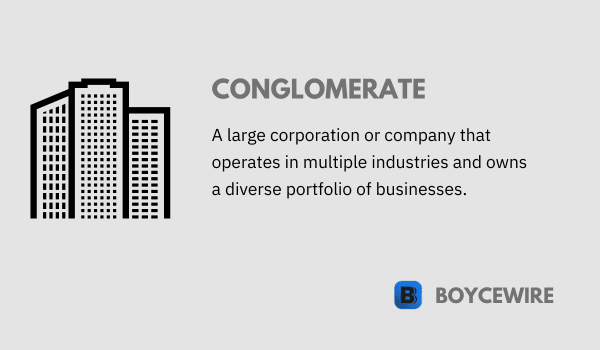Conglomerate: Definition, Pros, Cons & Examples

What is a Conglomerate?
In the dynamic world of business, where markets constantly evolve and industries continually transform, stands a fascinating entity known as the conglomerate. A conglomerate, by definition, is a large corporation that’s composed of a variety of different businesses, each operating in distinct industries. It’s a corporate structure that brings together diverse sectors under one umbrella, ranging from technology to healthcare, media to manufacturing, and beyond.
The concept of conglomerates is not a modern one. The history of conglomerates traces back to the 19th century, gaining significant prominence in the United States during the post-World War II economic boom. This was a time when companies pursued aggressive growth strategies, often leading to the formation of massive multi-industry corporations. Over time, the popularity of conglomerates has fluctuated, impacted by economic cycles, regulatory environments, and shifting business philosophies.
Key Points
- Conglomerates are large corporations or companies that operate in multiple industries and own a diverse portfolio of businesses.
- Conglomerates grow through mergers and acquisitions, acquiring other companies to expand their business operations and diversify their revenue streams.
- The purpose of forming a conglomerate is to achieve economies of scale, spread risks across different industries, and capitalize on synergies between their various businesses.
Characteristics of Conglomerates
Conglomerates are unique entities within the corporate landscape. Their defining traits reflect a level of complexity and diversification that sets them apart from other types of corporations. Here are the main characteristics of conglomerates:
1. Diversification
The most salient feature of conglomerates is their diversification. A conglomerate is composed of a multitude of businesses that operate in distinct industries or markets. This diversity allows conglomerates to spread their risks across various sectors, making them less susceptible to industry-specific downturns or fluctuations.
2. Size and Scale
Due to their structure and the range of their operations, conglomerates often represent significant economic scale. They tend to be large corporations with considerable resources, giving them substantial financial muscle. Their size can also provide them with bargaining power with suppliers, customers, and in some cases, even governments.
3. Multi-industry Operations
Unlike a typical corporation that focuses on a specific industry or sector, conglomerates operate in multiple industries. For example, a conglomerate may have a presence in the automotive industry, own a media company, and also run a chain of hotels. This range of operations is typically not linked, meaning the success or failure of one business does not directly impact the others.
4. Cross-Subsidization
Conglomerates often engage in cross-subsidization, using profits from their successful businesses to support other businesses within the conglomerate that may be struggling or are in a growth or investment phase. This ability to internally redirect funds can be a strategic advantage for conglomerates.
In essence, the conglomerate structure brings together an assortment of businesses that can create a diverse, resilient entity. The complexity of managing such an organization is considerable, but it also provides opportunities for risk mitigation and potential synergies.
Advantages of Conglomerates
Conglomerates can offer several advantages, both to the companies within them and to their shareholders. These advantages are often linked to the diversified nature of the conglomerate’s operations. Here are some key benefits:
1. Risk Management through Diversification
Perhaps the most significant advantage of conglomerates is the ability to spread risk across various industries. This diversification can protect the overall corporation from industry-specific downturns or market volatility. If one subsidiary underperforms or faces challenges, it’s likely that another could be thriving, thereby balancing the overall performance.
2. Synergy and Cross-Promotion
Though businesses within a conglomerate operate in different industries, there can still be opportunities for synergies and cross-promotion. For example, a conglomerate owning a movie production company and a chain of cinemas could promote its own films across its theaters. These synergies can help boost revenues and profits.
3. Financial Flexibility and Opportunities for Capital Allocation
With diverse businesses under one corporate umbrella, conglomerates have unique opportunities for internal capital allocation. Profits from one business can be used to fund investment in another, allowing for potentially efficient use of resources and providing financial stability. This internal capital market can be especially beneficial if external financing is costly or hard to access.
4. Greater Market Power
Due to their size and reach, conglomerates often have significant market power. They can negotiate better deals with suppliers and have more weight in price setting. Their size can also give them an advantage when it comes to lobbying efforts or negotiations with governments.
In conclusion, while conglomerates are complex entities that can be challenging to manage, they also offer a range of advantages. These benefits can make them attractive investments and powerful players in the global economy.
Disadvantages of Conglomerates
Despite the potential advantages, conglomerates also face a number of challenges and disadvantages. These stem from their size, complexity, and the inherent difficulties in managing diverse businesses. Here are some of the key disadvantages:
1. Complexity and Management Challenges
Managing a conglomerate is inherently complex. It involves overseeing a range of businesses, each with its own industry dynamics, competitive landscape, and operational requirements. This complexity can lead to inefficiencies and make it challenging for management to effectively allocate resources or make strategic decisions.
2. Regulatory Scrutiny and Antitrust Concerns
Given their size and market power, conglomerates often face significant regulatory scrutiny. They may be subject to antitrust investigations or actions if they are seen to be abusing their market power. Additionally, different businesses within the conglomerate may face distinct regulatory environments, increasing compliance complexity and risk.
3. Potential for Value Destruction
While conglomerates can potentially create value through synergies and efficient capital allocation, they also have the potential to destroy value. Poorly executed acquisitions can lead to overpayment or difficulty in integrating the new business. Similarly, the lack of focus resulting from diversification can lead to underperformance in some business units.
4. Lack of Focus and Potential Inefficiencies
A conglomerate’s diversified nature can lead to a lack of focus. Each subsidiary might require unique strategies and operational approaches, making it difficult for management to effectively focus on each business’s needs. This lack of focus can result in operational inefficiencies and missed opportunities.
In conclusion, while conglomerates can offer benefits through diversification and scale, they also face significant challenges. The success of a conglomerate often hinges on effective management and strategic decision-making to navigate these challenges and unlock the potential advantages.
Examples of Conglomerates
Berkshire Hathaway Inc.
Headquartered in the United States, Berkshire Hathaway is a multinational conglomerate holding company led by one of the world’s most renowned investors, Warren Buffett. It owns a diverse range of businesses including insurance (GEICO), utilities and energy (Berkshire Hathaway Energy), manufacturing (Precision Castparts), and even food (Dairy Queen). Berkshire Hathaway also holds significant stock investments in companies such as Apple and Coca-Cola.
Samsung Group
Samsung is a South Korean conglomerate known globally for its electronics, particularly smartphones and televisions. However, Samsung’s operations span a wide range of industries, including shipbuilding (Samsung Heavy Industries), construction (Samsung C&T), and even life insurance (Samsung Life Insurance).
Tata Group
Tata Group is an Indian multinational conglomerate holding company, owning businesses across numerous sectors. Notable entities within the group include Tata Steel, Tata Motors (which owns the British luxury car brand Jaguar Land Rover), Tata Consultancy Services, and Tata Consumer Products.
Siemens AG
Siemens is a German multinational conglomerate, one of the largest industrial manufacturing companies in Europe. Its operations span industry sectors such as energy, healthcare (Siemens Healthineers), transportation (Siemens Mobility), and automation.
General Electric (GE)
A U.S. multinational conglomerate, GE operates in sectors including aviation, power, renewable energy, and healthcare. GE has undergone significant restructuring in recent years to focus more on its core businesses.
These examples illustrate the vast scale and industry reach that conglomerates can achieve. They highlight how these corporations, through effective management and strategy, can thrive across disparate business sectors.
Conglomerates Around the World
Conglomerates have a global presence, with their prevalence and acceptance varying across different countries due to cultural, regulatory, and economic factors. Here are some notable perspectives on conglomerates around the world:
United States
In the United States, the era of conglomerates reached its peak in the 1960s and 1970s, when many companies pursued diversification as a strategy for growth and risk mitigation. Iconic conglomerates, such as General Electric and Berkshire Hathaway, have had significant influence on the country’s economy. However, the trend has shifted in recent decades towards more focused corporations, driven by factors like shareholder value maximization and the belief in ‘core competencies.’
Europe
In Europe, conglomerates are less common than in the U.S., with a greater emphasis traditionally placed on companies specializing in specific industries. However, several large conglomerates have originated in Europe, including Siemens AG in Germany and Unilever in the UK/Netherlands. The regulatory environment in the European Union, including its antitrust laws, may influence the formation and operations of conglomerates in this region.
Asia
In several Asian countries, including Japan and South Korea, conglomerates known as ‘Keiretsu’ and ‘Chaebol,’ respectively, play a substantial role in the economy. These conglomerates often have a familial or historical origin and have a considerable influence on their home economies. Examples include the Mitsubishi and Sumitomo groups in Japan and Samsung and Hyundai in South Korea.
India
In India, conglomerates, often family-owned, have played a significant role in the country’s economic development. These include Tata Group, Reliance Industries, and Aditya Birla Group, which have a presence across diverse sectors, from technology to textiles, and from energy to education.
In conclusion, the presence and influence of conglomerates vary significantly across different regions of the world, shaped by cultural, regulatory, and economic factors. Their adaptability and resilience continue to make them an essential component of the global economy.
FAQs
A conglomerate is a large corporation or company that operates in multiple industries and owns a diverse portfolio of businesses.
Conglomerates typically grow through mergers and acquisitions, acquiring other companies in different industries to expand their business operations and diversify their revenue streams.
The main purpose of forming a conglomerate is to achieve economies of scale, spread risks across different industries, and take advantage of synergies and cross-selling opportunities between their various businesses.
Conglomerates often have a decentralized management structure, with each subsidiary or business unit operating relatively independently under the conglomerate’s umbrella, while still benefiting from centralized support and resources.
About Paul
Paul Boyce is an economics editor with over 10 years experience in the industry. Currently working as a consultant within the financial services sector, Paul is the CEO and chief editor of BoyceWire. He has written publications for FEE, the Mises Institute, and many others.

Further Reading
 3 Types of Fiscal Policy - There are three types of fiscal policy; neutral, expansionary, and contractionary.
3 Types of Fiscal Policy - There are three types of fiscal policy; neutral, expansionary, and contractionary.  Price Elasticity of Demand: Definition, Types & Examples - Price Elasticity of Demand (PED) measures how customers change their behaviour when prices change. In other words, it refers to…
Price Elasticity of Demand: Definition, Types & Examples - Price Elasticity of Demand (PED) measures how customers change their behaviour when prices change. In other words, it refers to…  Marginal Propensity to Consume: Definition, Graph & Example - Marginal propensity to consume refers to the percentage of the additional income that is spent. In other words, if a…
Marginal Propensity to Consume: Definition, Graph & Example - Marginal propensity to consume refers to the percentage of the additional income that is spent. In other words, if a… 
